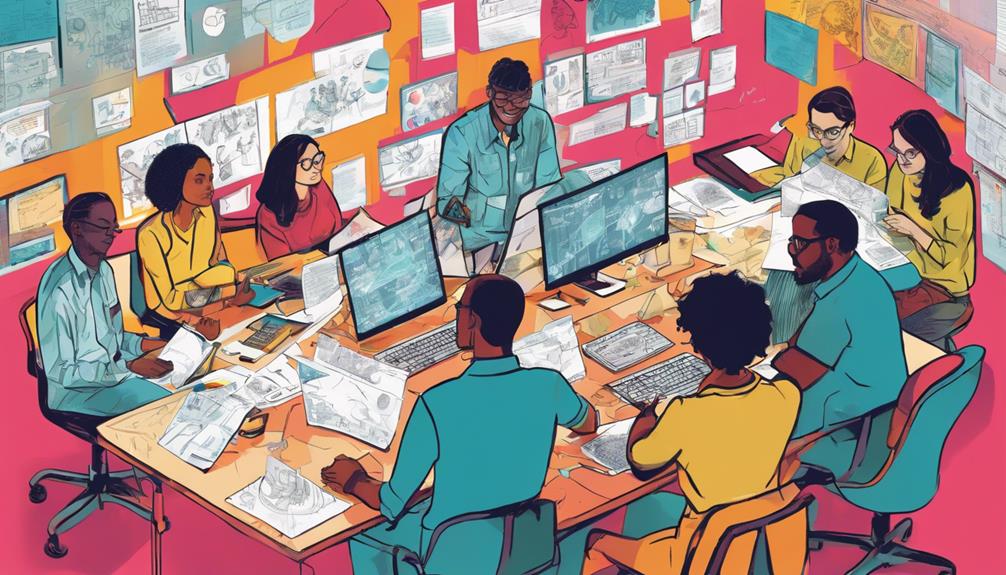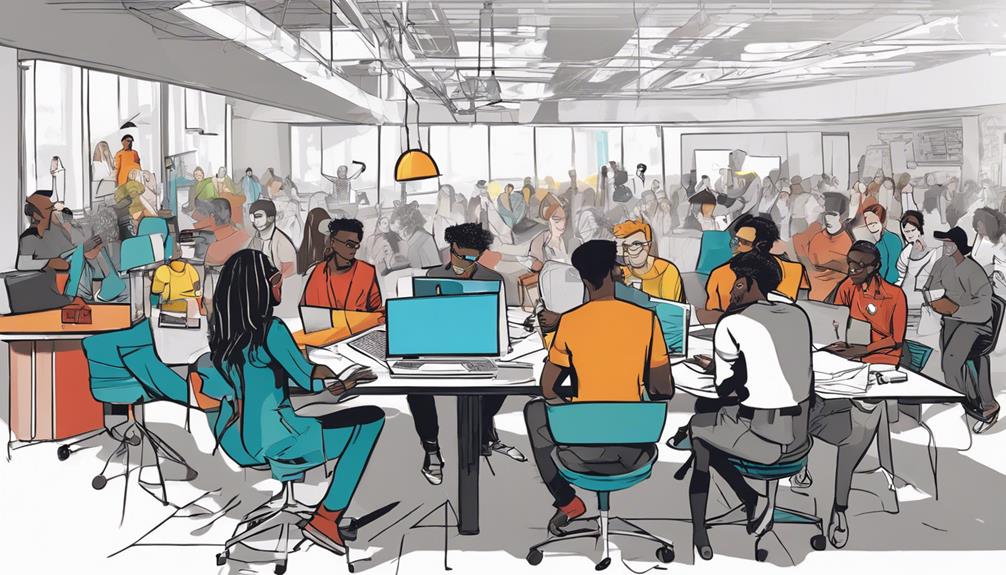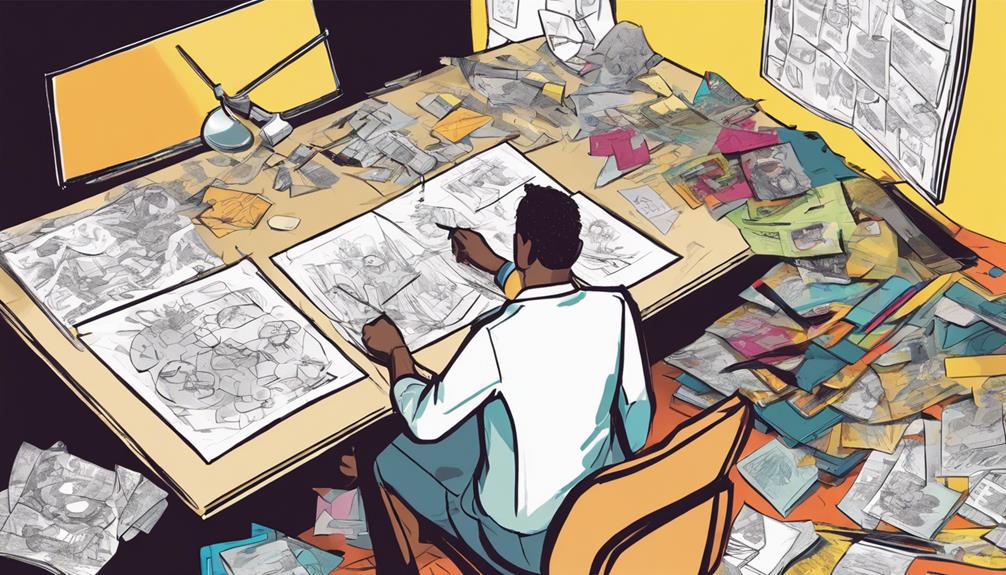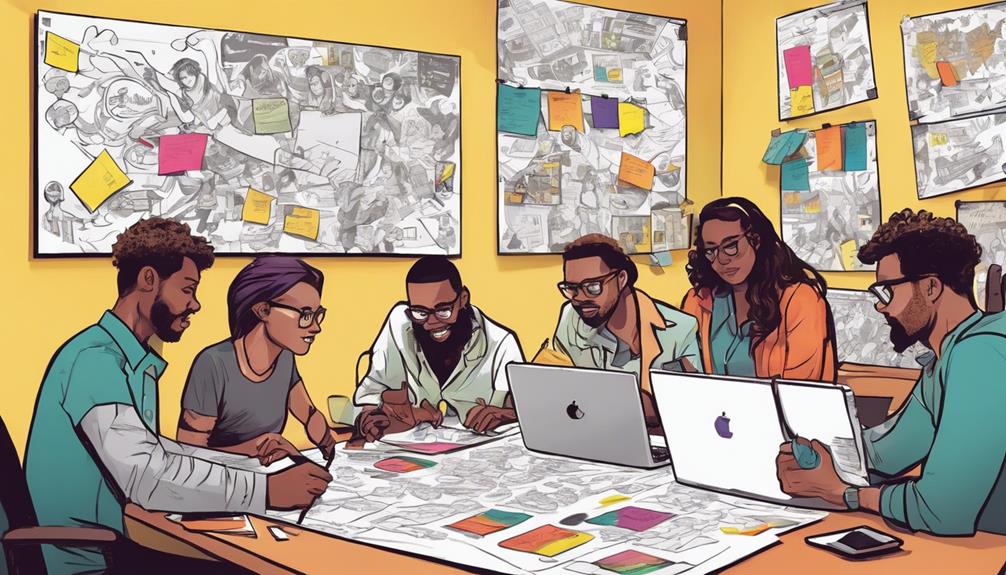Step into the vibrant realm of Stanford Design Thinking, where groundbreaking programs and immersive experiences cultivate your design skills. Explore innovative ideas and impactful solutions that inspire creative thinking. Engage in hands-on workshops and collaborative projects that push the boundaries of design concepts. Discover a hub of creativity, innovation, and transformation that empowers you to make a difference through design. Reveal a wealth of resources, events, and research initiatives that drive forward-thinking approaches. Embrace the holistic wellness practices and continuous learning embedded in the design process. Explore further to expose a world of endless possibilities in design and beyond.
Key Takeaways
- Stanford Design Thinking fosters innovation through hands-on workshops.
- The center bridges academia-industry gap with corporate partnerships.
- Curriculum development influences the future of design thinking education.
- Emphasis on overall well-being and personal growth within design programs.
- Design thinking promotes mental, physical, and emotional wellness in students.
Innovative Programs and Degrees
If you're considering pursuing innovative academic opportunities in design, Stanford d.school offers Bachelors and Masters programs tailored to your needs. These programs immerse you in the design thinking model, providing hands-on experiences to develop your skills in the design process.
At the d.school, you're encouraged to think creatively and shape the future through impactful design solutions. The academic offerings are designed to empower you to create change through design, fostering a culture of innovation and creativity within the student community.
By equipping you with the tools and mindset needed to drive meaningful design solutions across various sectors, the d.school inspires you to implement design thinking principles in your projects.
Whether you're looking to deepen your understanding of design or seeking to make a difference through innovative solutions, the programs at Stanford d.school are geared towards guiding you on your journey towards becoming a proficient and innovative design thinker.
Professional Development Offerings

Stanford d.school offers a range of professional development opportunities tailored to equip professionals from various sectors with practical design thinking skills.
These programs are designed to immerse participants in the design thinking framework, enabling them to tackle complex challenges with innovative solutions. By engaging in workshops and learning experiences, individuals can enhance their ability to apply design principles effectively in their work environments.
The d.school's professional development offerings cater to business, education, public sector, and K12 professionals who seek to drive positive change through design. The goal of these tailored programs is to empower participants to leverage design thinking methodologies to foster innovation, creativity, and impactful outcomes within their respective fields.
Through these initiatives, professionals can acquire the skills and tools necessary to navigate the design thinking process and develop solutions that address real-world problems efficiently.
Publications and Resources

Explore the wealth of publications and resources available at the d.school for valuable insights into design thinking and innovation. Whether you're a student, educator, or professional looking to dig deeper into the field of design thinking, the d.school offers a diverse range of materials to support your journey.
With 11 books published by the d.school, you can access activities, stories, and tools aimed at enhancing design thinking education. Educators at the d.school provide valuable insights and resources to help individuals navigate the intricacies of design thinking and spur innovation.
Stay connected with the latest projects and initiatives at the d.school through their various publications, which offer a glimpse into the cutting-edge work being done in the domain of design thinking. From hands-on design experiences to fostering creativity and innovation, the d.school provides a plethora of resources and tools to support your exploration of design thinking principles.
Immerse yourself in these materials to enhance your understanding and application of design thinking concepts.
Engaging Events and Workshops

Discover a dynamic array of engaging events and workshops hosted by the Stanford d.school, offering unique insights into design thinking and innovation.
Immerse yourself in thought-provoking sessions like 'Afro-Rithms From the Future', which explores Afrofuturism and Africanfuturism, providing a fresh perspective on the intersection of culture and design.
Explore the future of design at Stanford through events like 'Making with Mischief', where innovative ideas take center stage, pushing the boundaries of traditional design concepts.
Engage with industry experts and alumni in the field of design thinking through the Alumni Spotlight series, featuring individuals like Scott Sanchez who share valuable insights and experiences.
Participate in hands-on workshops like the Work Project Launch Bootcamp 2.0, where design methods are utilized to foster creativity and innovation in project development.
Additionally, the Creativity in Research Scholars program offers Stanford PhD students a unique opportunity to apply design thinking principles to their academic research, fostering a culture of innovation within academia.
Explore, learn, and innovate with these interactive events and workshops at the Stanford d.school.
Tools for Creativity and Design

Immerse yourself in a toolkit of resources for creativity and design at Stanford's Launchpad Venture Hub. The hub, led by experienced professors in design and innovation, offers Educator Guides and creation kits that support innovative project development. These tools are valuable for crafting engaging activities and learning experiences.
Specifically tailored resources are available for designing social media content focused on promoting youth mental health and well-being. These tools not only aid in project design but also facilitate adaptability across various settings, fostering creativity and innovation.
For those seeking further information or updates on the resources and tools available, reaching out to the relevant contacts at Stanford is a straightforward process. Whether you're a budding entrepreneur or an experienced innovator, these tools cater to a diverse range of needs.
Enhance your capacity for creative and impactful project development at Stanford's Launchpad Venture Hub.
SCIDR: Advancing Innovation Knowledge

SCIDR's global innovator community and research in key industries make it a hub for advancing innovation knowledge.
By bringing together scholars and industry practitioners, SCIDR fosters cutting-edge practices that drive collaborative initiatives with partners.
The center's focus on design thinking and shaping the future of business innovation guarantees a diverse and impactful approach to advancing knowledge.
Global Innovator Community
At the forefront of innovation knowledge advancement within the design thinking domain sits the Global Innovator Community, a dynamic hub for scholars and industry practitioners worldwide.
SCIDR, also known as cider, focuses on advancing knowledge at the intersection of innovation processes and design thinking, welcoming members from organizations of all sizes globally.
Research at SCIDR explores various industries such as food, mobility, and lifestyle design, fostering collaboration with partners to drive impactful initiatives.
The community's expertise shines in design thinking research, particularly in the food industry, employing a human-centered approach grounded in design research from Stanford University.
SCIDR aims to inspire innovative practices that create a positive impact, cultivating fresh insights at the crossroads of business innovation and design thinking.
Joining this global community offers a unique opportunity to engage with cutting-edge research and collaborate with diverse experts passionate about driving innovation forward.
Research in Key Industries
Exploring key industries such as food, mobility, and lifestyle design, SCIDR actively advances innovation knowledge through collaborative research initiatives. The center collaborates with partners to investigate cutting-edge approaches in areas like autonomous driving and robotics while guiding food companies to meet consumer needs successfully.
SCIDR's research initiatives, rooted in design thinking principles, shape the future of mobility for younger generations and drive industry changes. The center's expertise spans various sectors, emphasizing a human-centered design research approach that aligns with Stanford University's core principles.
- SCIDR focuses on research in food, mobility, and lifestyle design to drive innovation and address industry challenges.
- The center collaborates with partners to examine cutting-edge approaches in areas like autonomous driving and robotics.
- SCIDR's human-centered approach guides food companies to meet consumer needs and innovate successfully in the industry.
- Research initiatives at SCIDR are centered on design thinking principles, shaping the future of mobility for younger generations.
Research Focus and Scholarly Contributions

Research at the Stanford Design Thinking center delves deeply into the core principles and methodologies of design thinking, aiming to advance the field through innovative partnerships and cutting-edge approaches.
By focusing on shaping the future of design thinking, the center contributes significantly to scholarly publications that enhance design thinking education.
Implementing cutting-edge methods and human-centered design principles, the research drives innovative solutions that address real-world challenges.
Through interdisciplinary collaborations and practical learning experiences, students enhance their problem-solving skills and prepare for industry demands.
The center's emphasis on pushing the boundaries of traditional design thinking fosters a culture of continuous learning and adaptation.
As a result, Stanford Design Thinking's research not only advances the field but also equips individuals with the skills and mindset needed to make a meaningful impact in various sectors.
Impact on Education and Industry

The impact of Stanford Design Thinking on education and industry is evident through its hands-on workshops and collaborative projects with corporate partners. Stanford's design thinking education equips students with practical problem-solving skills through real-world projects, enhancing their readiness for industry challenges.
The innovation hub offers hands-on design thinking workshops that further prepare students for the complexities of the professional world. Corporate partnerships drive innovation by collaborating on research projects that address real-world design challenges, bridging the gap between academia and industry.
Additionally, the design thinking curriculum development at Stanford influences the future of design thinking education, ensuring that students are at the forefront of innovative practices. Industry leaders also benefit from consultancy services at Stanford, where they can integrate design thinking into their corporate strategies for enhanced competitiveness.
Corporate Partnerships and Collaborations

You'll investigate the dynamic industry collaboration initiatives and corporate innovation partnerships facilitated by Stanford Design Thinking. Discover how these partnerships drive innovative solutions and enhance creative processes within corporations.
Get ready to immerse yourself in the impactful outcomes of these collaborative efforts.
Industry Collaboration Initiatives
Engaging in corporate partnerships, Stanford Design Thinking drives innovation and real-world impact through collaborative initiatives with industry leaders.
The center offers consultancy services to assist companies in integrating design thinking into their processes effectively. By collaborating with industry leaders, Stanford Design Thinking facilitates knowledge exchange and addresses corporate design challenges to foster innovative solutions.
Additionally, training programs are provided for corporate teams to enhance their design thinking capabilities, enabling them to tackle complex problems with a human-centered approach.
Through research projects, Stanford Design Thinking further supports businesses in developing creative and effective solutions for industry-specific challenges, ultimately contributing to the advancement of innovation in the corporate world.
Corporate Innovation Partnerships
Collaborating with industry leaders, Stanford Design Thinking drives corporate innovation through strategic partnerships and collaborations. By working closely with companies, the d.school offers consultancy services to help integrate design thinking into corporate strategies effectively. Through tailored training programs, corporate teams can enhance their design thinking capabilities, fostering innovation within their organizations.
Facilitating knowledge exchange between academia and industry, Stanford addresses corporate design challenges by leveraging the latest insights and methodologies. Research projects at Stanford focus on applying design thinking principles to solve real-world corporate innovation issues, providing valuable solutions and driving forward the field of design thinking in a corporate context.
These collaborative efforts not only benefit the companies involved but also contribute to the broader ecosystem of innovation and creativity. By nurturing these corporate innovation partnerships, Stanford Design Thinking continues to be at the forefront of driving impactful change in the business world.
Holistic Wellness and Lifelong Learning

Holistic wellness and lifelong learning are foundational principles integrated within Stanford's design thinking approach, emphasizing the importance of overall well-being and continuous personal growth. Stanford's design thinking philosophy promotes mental, physical, and emotional well-being, recognizing the significance of a holistic approach to creativity.
Furthermore, the emphasis on lifelong learning encourages individuals to continuously expand their knowledge and skills, fostering personal development and adaptability in an ever-evolving world.
- Promotion of Mental, Physical, and Emotional Well-being: Stanford's design thinking approach prioritizes the well-being of individuals by considering all aspects of health.
- Encouragement of Continuous Education: Lifelong learning is actively encouraged within Stanford's design thinking programs, highlighting the value of ongoing personal growth.
- Integration of Wellness Practices: The innovation hub at Stanford incorporates wellness practices into the design process, creating a sustainable approach to creativity.
- Empowerment for Impactful Solutions: By focusing on holistic wellness and lifelong learning, Stanford's design thinking initiatives empower individuals to generate meaningful and impactful solutions.
Frequently Asked Questions
What Is the Stanford Model of Design Thinking?
The Stanford model of design thinking is a human-centered approach focused on empathizing, defining, ideating, prototyping, and testing solutions. It encourages multidisciplinary collaboration and aims to empower individuals to innovate through empathy and iteration.
What Are the Five Phases of the Stanford D School Design Thinking Process?
Oh, you want to know the five phases of the Stanford d.school design thinking process? Well, get ready to empathize, define, ideate, prototype, and test your way to innovative solutions!
What Is the Difference Between the IDEO Method of Design Thinking and That of the Stanford Design School?
The difference between the IDEO method of design thinking and Stanford d.school's approach lies in the additional step of problem definition by the latter. Stanford's process emphasizes human-centered design, collaboration, and structured innovation.
What Are the Design Thinking Phases of Stanford Empathy and Ideo Discovery?
Explore the phases of Stanford Design Thinking's empathy and IDEO's discovery. Immerse yourself in understanding user needs through observation and insights from diverse sources to spark innovative ideas. Embrace human-centered design principles for impactful solutions.
Conclusion
You've seen the endless possibilities of design thinking at Stanford's innovation hub. Remember, as the saying goes, 'Innovation distinguishes between a leader and a follower.'
So, go forth and embrace your creative potential, challenge the status quo, and make a lasting impact in your field. Keep pushing boundaries, thinking outside the box, and never stop learning.
The world is waiting for your next big idea!









